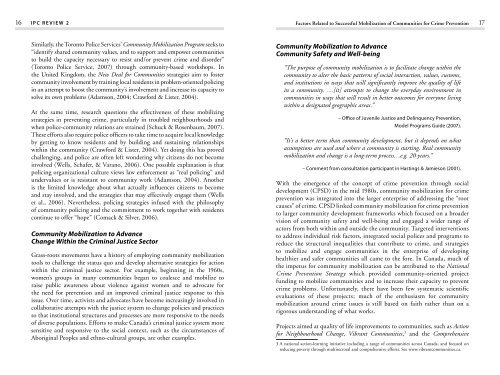Revue de L' R e v I e W - Faculty of Social Sciences - Université d ...
Revue de L' R e v I e W - Faculty of Social Sciences - Université d ...
Revue de L' R e v I e W - Faculty of Social Sciences - Université d ...
You also want an ePaper? Increase the reach of your titles
YUMPU automatically turns print PDFs into web optimized ePapers that Google loves.
16 I P C R e v i e w 2 Factors Related to Successful Mobilization <strong>of</strong> Communities for Crime Prevention 17<br />
Similarly, the Toronto Police Services’ Community Mobilization Program seeks to<br />
“i<strong>de</strong>ntify shared community values, and to support and empower communities<br />
to build the capacity necessary to resist and/or prevent crime and disor<strong>de</strong>r”<br />
(Toronto Police Service, 2007) through community-based workshops. In<br />
the United Kingdom, the New Deal for Communities strategies aim to foster<br />
community involvement by training local resi<strong>de</strong>nts in problem-oriented policing<br />
in an attempt to boost the community’s involvement and increase its capacity to<br />
solve its own problems (Adamson, 2004; Crawford & Lister, 2004).<br />
At the same time, research questions the effectiveness <strong>of</strong> these mobilizing<br />
strategies in preventing crime, particularly in troubled neighbourhoods and<br />
when police-community relations are strained (Schuck & Rosenbaum, 2007).<br />
These efforts also require police <strong>of</strong>ficers to take time to acquire local knowledge<br />
by getting to know resi<strong>de</strong>nts and by building and sustaining relationships<br />
within the community (Crawford & Lister, 2004). Yet doing this has proved<br />
challenging, and police are <strong>of</strong>ten left won<strong>de</strong>ring why citizens do not become<br />
involved (Wells, Schafer, & Varano, 2006). One possible explanation is that<br />
policing organizational culture views law enforcement as “real policing” and<br />
un<strong>de</strong>rvalues or is resistant to community work (Adamson, 2004). Another<br />
is the limited knowledge about what actually influences citizens to become<br />
and stay involved, and the strategies that may effectively engage them (Wells<br />
et al., 2006). Nevertheless, policing strategies infused with the philosophy<br />
<strong>of</strong> community policing and the commitment to work together with resi<strong>de</strong>nts<br />
continue to <strong>of</strong>fer “hope” (Comack & Silver, 2006).<br />
Community Mobilization to Advance<br />
Change Within the Criminal Justice Sector<br />
Grass-roots movements have a history <strong>of</strong> employing community mobilization<br />
tools to challenge the status quo and <strong>de</strong>velop alternative strategies for action<br />
within the criminal justice sector. For example, beginning in the 1960s,<br />
women’s groups in many communities began to coalesce and mobilize to<br />
raise public awareness about violence against women and to advocate for<br />
the need for prevention and an improved criminal justice response to this<br />
issue. Over time, activists and advocates have become increasingly involved in<br />
collaborative attempts with the justice system to change policies and practices<br />
so that institutional structures and processes are more responsive to the needs<br />
<strong>of</strong> diverse populations. Efforts to make Canada’s criminal justice system more<br />
sensitive and responsive to the social context, such as the circumstances <strong>of</strong><br />
Aboriginal Peoples and ethno-cultural groups, are other examples.<br />
Community Mobilization to Advance<br />
Community Safety and Well-being<br />
“The purpose <strong>of</strong> community mobilization is to facilitate change within the<br />
community to alter the basic patterns <strong>of</strong> social interaction, values, customs,<br />
and institutions in ways that will significantly improve the quality <strong>of</strong> life<br />
in a community. …[it] attempts to change the everyday environment in<br />
communities in ways that will result in better outcomes for everyone living<br />
within a <strong>de</strong>signated geographic areas.”<br />
– Office <strong>of</strong> Juvenile Justice and Delinquency Prevention,<br />
Mo<strong>de</strong>l Programs Gui<strong>de</strong> (2007).<br />
“It’s a better term than community <strong>de</strong>velopment, but it <strong>de</strong>pends on what<br />
assumptions are used and where a community is starting. Real community<br />
mobilization and change is a long-term process…e.g. 20 years.”<br />
– Comment from consultation participant in Hastings & Jamieson (2001).<br />
With the emergence <strong>of</strong> the concept <strong>of</strong> crime prevention through social<br />
<strong>de</strong>velopment (CPSD) in the mid 1980s, community mobilization for crime<br />
prevention was integrated into the larger enterprise <strong>of</strong> addressing the “root<br />
causes” <strong>of</strong> crime. CPSD linked community mobilization for crime prevention<br />
to larger community <strong>de</strong>velopment frameworks which focused on a broa<strong>de</strong>r<br />
vision <strong>of</strong> community safety and well-being and engaged a wi<strong>de</strong>r range <strong>of</strong><br />
actors from both within and outsi<strong>de</strong> the community. Targeted interventions<br />
to address individual risk factors, integrated social polices and programs to<br />
reduce the structural inequalities that contribute to crime, and strategies<br />
to mobilize and engage communities in the enterprise <strong>of</strong> <strong>de</strong>veloping<br />
healthier and safer communities all came to the fore. In Canada, much <strong>of</strong><br />
the impetus for community mobilization can be attributed to the National<br />
Crime Prevention Strategy which provi<strong>de</strong>d community-oriented project<br />
funding to mobilize communities and to increase their capacity to prevent<br />
crime problems. Unfortunately, there have been few systematic scientific<br />
evaluations <strong>of</strong> these projects; much <strong>of</strong> the enthusiasm for community<br />
mobilization around crime issues is still based on faith rather than on a<br />
rigorous un<strong>de</strong>rstanding <strong>of</strong> what works.<br />
Projects aimed at quality <strong>of</strong> life improvements to communities, such as Action<br />
for Neighbourhood Change, Vibrant Communities, and the Comprehensive<br />
A national action-learning initiative including a range <strong>of</strong> communities across Canada, and focused on<br />
reducing poverty through multisectoral and comprehensive efforts. See www.vibrantcommunities.ca.

















